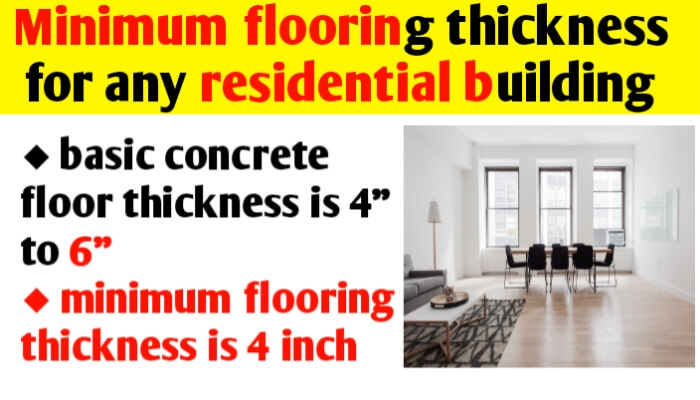The minimum flooring thickness in residential buildings can vary based on factors such as the type of flooring material and local building codes. Common thickness ranges for flooring materials are:
1. Hardwood: Typically 3/4 inch (19 mm).
2. Engineered Wood: Varies, but commonly around 3/8 to 1/2 inch (9.5 to 12.7 mm).
3. Laminate: Usually 7-12 mm.
4. Tile: Thickness depends on the type, but it can range from 1/4 to 1/2 inch (6.35 to 12.7 mm).
5. Concrete:- Typically 3″ to 5″ (8 to 12 cm).
Minimum flooring thickness in any residential building, hi guys in this article you know about ground floor’s flooring thickness, 1st floor’s flooring thickness and what is minimum flooring thickness in any residential building.
◆You Can Follow me on Facebook and Subscribe our Youtube Channel
You should also visits:-
1)what is concrete and its types and properties
2) concrete quantity calculation for staircase and its formula
A floor will need to provide for one or more of the following: structural support of the room’s contents and users and the weight of the floor itself; and If the floor is a ground floor, provide resistance to ground moisture; and heat loss (thermal insulation).
Ground flooring provide resistance to ground moisture capillary action and prevent from dampness and also it is prevent from heat loss thermal insulation, so proper thickness required for flooring.

The minimum flooring thickness for residential buildings
The minimum flooring thickness for residential buildings can vary based on the type of flooring material used. However, a common range is: 0.25 to 0.75 feet, 3 to 9 inches, 0.080 to 0.230 meters, 8 to 23 centimeters, or 80 to 230 millimeters.
Generally, residential floors should be at least 3 inches thick, while industrial floors need to be at least 6 inches thick for light to medium use, and 8 inches thick for heavy use. For example, a warehouse that will store heavy machinery or large amounts of inventory should have a floor.
Types of ground flooring construction
There are three general types of ground flooring construction: 1) Solid floor, 2) suspended Timber floor and 3) suspended concrete floor.
1) Solid floor: A solid floor is typical way of constructing a solid floor for ground flooring would be to provide a base of hardcore with sand blinding material, with a layer of concrete over that.
To ensure a level finish to the ground floor, a layer of screed is added over the top of the concrete, which consists of sand and cement. A suitable gauge damp proof membrane (DPM) can be used and thermal insulation must be provided. These can be laid over the sand blinding or on top of the concrete
2) Suspended Timber Floor: As a requirement of the Building Regulations the structure should be protected against the growth of weeds and other plant-life. The ground should have a layer of concrete poured across and there should be a ventilated gap of at least 150mm between the underside of the timbers and the concrete, to prevent moisture gathering and affecting the condition of the joists.
The timber floor joists should be sized correctly depending on their span (length between supports) and are normally laid across the shortest span from wall to wall with a gap underneath.
3) Suspended Concrete floor: This construction is similar to the timber floor above, but uses either pre-cast concrete planks or small pre-cast concrete beams with concrete blocks laid between the beams. They can normally span greater distances than timber joists.
Ventilation is required in the same way as a suspended timber floor. The manufacturers may well work out the size of the concrete beams and provide the structural calculations.
The minimum floor thickness for G+0, G+1, G+2 building
The minimum floor thickness ranging from 6 inches to 8 inches thick for G+1, G+2, G+3 residential building those consist of beam & column structure, depending upon the type of floor finish and false flooring (if any).
Typically 4 to 6 inches is basic concrete flooring thickness without finishes and depends on various aspects like loading conditions, grade of concrete and even the grade of reinforcement inside.
Typically 4 to 6 inches is basic concrete flooring thickness for ground’s floor without finishes and depends on various aspects like loading conditions, grade of concrete and even the grade of reinforcement inside.
Typically 4 to 6 inches is basic concrete flooring thickness for first (1st) floor without finishes and depends on various aspects like loading conditions & grade of concrete.
Minimum flooring thickness:- minimum flooring thickness is restricted to 4 inch with good grade of concrete and even grade of reinforcement inside it.
I have adopted minimum flooring thickness is 4” thick PCC 1:2:4, m15 grade of concrete using 1.5 inch hard broken stone and top plastered with cement mortar 1:4, 3/4” thick in many residential buildings and flooring of 1:3 (one part of Cement and three of broken stone chips of 1/4” and below size and no sand) of 3/4” thick was laid in first floor ( of RCC slab).
After that you add the finishing thickness like marble, granite or other stones. Wooden flooring can also be used generally having a thickness of 7mm to 12mm after a base grid of 1cm.
Floor thickness is not dependent on which floor you construct unless you’re using a load bearing construction system. So it’s the same for every floor.
Conclusion:-
The minimum flooring thickness can range from 0.25 to 0.75 feet, 3 to 9 inches, 0.080 to 0.230 meters, 8 to 23 centimeters, or 80 to 230 millimeters.